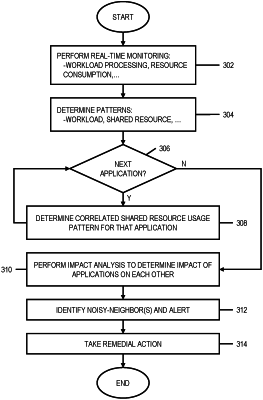| CPC G06F 9/505 (2013.01) [G06F 9/5077 (2013.01); G06F 11/0793 (2013.01); G06F 11/0709 (2013.01); G06F 11/3006 (2013.01); G06F 2209/5021 (2013.01); G06F 2209/508 (2013.01)] | 17 Claims |

|
1. A computer-implemented method comprising:
performing real-time monitoring of workload processing and associated resource consumption of a plurality of application components that use one or more shared resources of a computing environment;
determining, based on the monitoring, workload and shared resource consumption patterns for each of the plurality of application components;
for each application, of a plurality of applications, that includes a respective at least one application component of the plurality of application components, correlating the determined workload and shared resource consumption patterns of each of the respective at least one application component of that application and determining a correlated shared resource usage pattern for that application, wherein the correlating provides correlated shared resource usage patterns for the plurality of applications;
performing impact analysis in real-time to determine impact of the plurality of applications on each other, wherein the performing the impact analysis uses an anomaly detector that is provided the correlated shared resource usage patterns as time-based inputs to the anomaly detector;
wherein each of the plurality of applications is assigned a respective application priority, and wherein the performing the impact analysis uses application priorities of a group of applications to resolve one of the group of applications as being a noisy-neighbor to another application of the group of applications;
identifying, based on the impact analysis, one or more noisy-neighbors that use the one or more shared resources, and automatically raising an alert indicating the one or more noisy-neighbors; and
taking, based on the impact analysis, remedial action affecting resource allocation of the one or more shared resources to the one or more noisy-neighbors.
|